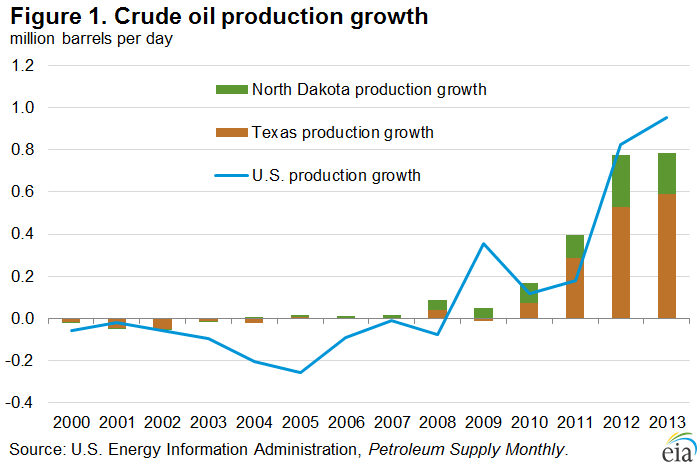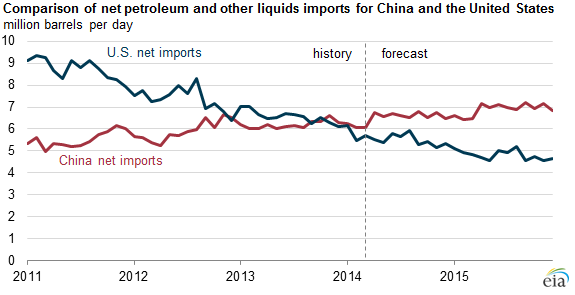Oil Production in the United States has been growing by leaps and bounds due to shale oil production made possible by horizontal drilling and hydraulic fracturing and is now at a 25 year high. Oil production in 2013 totaled 7.5 million barrels per day, a level not seen since 1989. Oil production in 2013 was almost a million barrels per day higher than oil production in 2012—a 15 percent increase and the largest annual increase since 1940. The increase in oil production has brought a boom to other sectors with rail car oil shipments up 83 percent and the oil tanker construction business booming with over 15 tanker orders. With greater oil production, the United States is importing less crude oil and petroleum– 16 percent less in 2013 than in 2012 on a net basis (imports minus exports). In fact, as of September 2013, China has replaced the United States as the largest net importer of crude oil and petroleum.
Oil Production at a 25 Year High
The increased oil production in 2013 is mostly due to shale oil production in Texas and North Dakota. The Bakken oil field in North Dakota and the Eagle Ford in Texas together accounted for 83 percent of the oil production increase in 2013. The Bakken oil field averaged 0.9 million barrels per day in 2013 and the Eagle Ford produced an annual average of 1.22 million barrels per day. [i]
Source: http://www.wallstreetsectorselector.com/2014/03/u-s-oil-production-hits-25-year-high/
The record crude oil production pushed refinery utilization up to 88 percent for 2013 from 83 percent in 2009.
Due to the higher oil production, net crude oil and petroleum imports decreased to 6.2 million barrels per day—the lowest level since 1987. The 2013 level was 1.15 million barrels per day (16 percent) less than net crude oil and petroleum imports in 2012. Net crude oil and petroleum imports reached their peak in 2005 at 12.5 million barrels per day and have declined by 50 percent from that peak.
China Exceeds U.S. in Net Petroleum Imports
In September 2013, China’s net imports of crude oil and petroleum products exceeded those of the United States, making it the largest net importer of crude oil and petroleum liquids in the world. U.S. total annual petroleum liquids production is expected to increase to 13.4 million barrels per day in 2014 – a growth of 31 percent since 2011. With U.S. demand expected to be 18.9 million barrels per day in 2014, its net crude oil and petroleum import level in 2014 would be just 5.5 million barrels per day.[ii] China, on the other hand, is expected to increase demand to over 11 million barrels per day but increase its petroleum liquids production by just 5 percent to a third of U.S. production in 2014, making net crude oil and petroleum imports reach about 6 million barrels per day.
Source: Energy Information Administration, http://www.eia.gov/todayinenergy/detail.cfm?id=15531&src=email
In recent years, China has been diversifying the sources of its crude oil imports due to its oil demand growth and geopolitical uncertainties. Saudi Arabia continues to be the largest supplier of crude oil to China, providing 19 percent of China’s 5.6 million barrels per day of imports in 2013. China also imports from Oman, Iraq, the United Arab Emirates, Angola, Venezuela, Russia, Iran, Libya, and Sudan and South Sudan.[iii]
U.S. Oil Production Boom Creates Boom in Rail Shipments and Tanker Construction
The U.S. oil production boom has created a boom in oil rail shipments, particularly given that the Keystone XL pipeline has been delayed by the Obama Administration for over 5 years now. According to the Association of American Railroads, major U.S. railways delivered 434,042 carloads of crude oil in 2013, 83 percent more than the amount shipped in 2012 (236,556 carloads of crude oil).[iv]
The U.S. energy boom is also having an effect on the country’s shipbuilding industry. Just three years ago, the oil tanker market was dormant in the United States, but was changed by the shale oil boom and the need to move the oil to refiners in the United States. According to the American Maritime Partnership, there are more than 15 oil tankers, along with hundreds of smaller tugs and barges, on order at U.S. shipyards across the country. And it will take years to build them.
For example, two oil tankers are being constructed at the Aker Philadelphia Shipyard for SeaRiver Maritime, a subsidiary of Exxon Mobil, at a cost of $200 million each. To build the tankers, it takes about 1,000 employees, working more than a year. The shipyard has orders for four more tankers and two container ships.[v]
While the domestic energy supply is booming, oil companies cannot use foreign ships to move oil and gas around the country due to a 1920 federal law called the Jones Act. Due to the Jones Act, vessels can only move between U.S. ports if they are flagged under U.S. law, crewed by American citizens and built in U.S. shipyards. Since World War II, shipbuilding in the United States has declined dramatically with only a handful of major shipyards now constructing ships, mostly for the Navy. Thus, the industry is having a hard time meeting the demand for merchant ships at an affordable price. The cost of construction is about three times as much at U.S. shipyards as it is in shipyards in China, Japan and South Korea.
Conclusion
Advanced techniques like horizontal drilling and hydraulic fracturing have turned our shale oil resources into an oil production bonanza that is reducing our dependence on foreign oil and creating a boom in rail shipments of crude oil and oil tanker construction. They have also helped to make the United States rank second to China in net crude oil and petroleum imports since September of last year.
But the industry is being hampered by Federal laws and policies that are making it difficult to move the crude oil around the country and to help our allies. Lack of adequate access to federal energy resources, a ban on crude oil exports in effect since 1975 due to the 1973 Arab Oil Embargo, a 5-year delay in providing a permit for the Keystone XL pipeline, and the 1920s Jones Act are all having negative effects on the potential growth opportunity that domestic production promises. The Jones Act has induced the construction of over 15 tankers in U.S. shipyards, which will take years to build, and make energy companies rely on rail, existing pipelines and road transport to move domestic oil and gas around the country.
[i] Wall Street Sector Selector, U.S. Oil Production Hits 25 Year High, March 14, 2014, http://www.wallstreetsectorselector.com/2014/03/u-s-oil-production-hits-25-year-high/
[ii] Energy Information Administration, Short-Term Energy Outlook, March 11, 2014, http://www.eia.gov/forecasts/steo/tables/pdf/4atab.pdf
[iii] Energy Information Administration, China is now the world’s largest net importer of petroleum and other liquid fuels, March 24, 2014, http://www.eia.gov/todayinenergy/detail.cfm?id=15531&src=email
[iv] The Hill, Railway crude oil shipments up over 83 percent, March 14, 2014, http://thehill.com/blogs/e2-wire/e2-wire/200814-railway-crude-oil-shipments-up-83-percent
[v] National Public Radio, A Boom in Oil Is A Boom for U.S. Shipbuilding Industry, March 14, 2014, http://www.npr.org/2014/03/14/289849961/a-boom-in-oil-is-a-boon-for-u-s-shipbuilding-industry





